Posts Tagged ‘magicband’
 Magic Band And The DX Window
Magic Band And The DX Window

Late May and early June always sees 6m come to life ... sometimes slowly and sometimes with a 'bang'. Last year's good early start soon flickered-out into what was the poorest sporadic-e season that many could recall. This year's 'start' has almost been a no-show, with just a very few short openings to the south eastern states (Colorado, Utah) and one 'blink and you've missed it' opening to the Great Lakes.
Hopefully the 6m propagation gods are just having some fun with us and things will really spring to life shortly. Once we do get into some periods of good propagation, there are always new arrivals to the band, as most transceivers these days include the 6m band. Every season I hear of newcomers getting their knuckles wrapped for, probably unknowingly and in all innocence, operating inside the 'DX Window'.
If you're new to the band or perhaps not sure how the window should work, here's a short section taken from my Magicband web page, that explains the concept:
Don't Be A 'DX-Window' Lid!
One of the quickest ways to get the 6m community saying nasty things about you behind your back is to mess-up in the DX Window. The DX Window (50.100 - 50.125 kHz) has long been established for one type of contact only, that being a legitimate DX QSO.
The DX Window can only be of value if everyone follows these basic 'rules':
If you are in the U.S.A. or Canada, DO NOT WORK ANY OTHER U.S.A. or CANADIAN STATIONS INSIDE THE WINDOW. The window is NOT for North America - North America contacts.
Do not answer the "CQ" of U.S.A. or VE stations if you are in North America. This creates unnecessary QRM and chances are, they will not respond to your answer anyway. Calling or answering other North Americans in the DX-Window only reinforces bad operating habits, encouraging newcomers to do the same. If you want to work U.S.A. or CANADA, do it outside the DX Window!
Work or call only stations outside of North America inside the DX Window.
The only legitimate exception to these rules, that will not get you in the naughty-corner, is working a KL7, VE8, XE or some other such fairly rare North Americans.
I hate to say it, but some of the worst offenders to the successful function of the DX Window are my fellow VE's, many of whom don't know or don't understand the simple concept of how it works. Now that you know, pass it on!
Now, you may or may not agree with the concept of a DX window, so please don't shoot the messenger. What I do know however, is that if everyone does their best to adhere to the window's concept, it works well. Problems arise when those that should know better, and probably do, decide that for some reason, the concept doesn't apply to them or that it won't hurt, 'just this once'. Others, particularly newcomers, see it and think it's all OK and soon the window is full of domestic QSO's, effectively killing its usefulness.
As conditions slowly improve, hopefully we can work on six this summer. I usually hang out on CW, just below 50.100. As one long-time 6m diehard would often say to me, the newcomer over 40 years ago ... 'We'll see you, all of a sudden!"
 6m SSSP JA’s
6m SSSP JA’s
 |
| JA7DYN's Station |
Six meters delivered a mid-afternoon surprise yesterday, with a brief opening between the west coast and Japan. It was one of those openings that would have been missed entirely, a few years ago.
At around 2300Z, JE1BMJ (Han), announced via the ON4KST 50MHz chat page that he would be CQ'ing towards North America on 50.090KHz. I was working at the bench with the receiver running in the background and took a moment to turn my 4el yagi towards Japan and put the receiver on frequency. Nothing was heard for several minutes when, as if a switch had been thrown, the frequency became alive with CW sending "... DX K". About 20 seconds later it started again, a CQ DX from JE1BMJ. It is amazing how often the band or a path will appear to suddenly open, in this case, at just the tail end of Kas's CQ ... not a whisper of anything before the very tail end. As I listened, his signal built from the initial 559 to 579 at which point I called and we exchanged signal reports.
I moved down the band and called CQ DX and was immediately called by several loud JA stations. Over the course of the short opening (just 15 minutes from start to finish), I worked the following stations in Japan:
JE1BMJ
JA1VOK
JR2HCB
JF1UMK
JAØRUG
JM1IGJ
JG1TSG
JHØKHR
JF1IRW
JA7DYN
JK1EXO
As mentioned earlier, this was an opening that would probably have been missed a few years ago, for several reasons. One factor is the growing use of the Internet to spot activity or stations that are actually on-the-air in real time. Another reason is the very short window of opportunity. Without stations looking, thanks to Han's QRV announcement, it is probable that nobody would have been pointing towards Japan at that time of the day ... but, more likely, the biggest reason is the exploitation of the SSSP path between NA and Asia that has become somewhat of a regular occurrence over the past several summers.
SSSP or Short-path Summer Solstice Propagation is the mechanism uncovered by JE1BMJ in 1999. In that year he discovered that his signals could be heard almost daily in many parts of Europe by transmitting on a regular evening schedule. He then turned his attention to North America, in the morning, and found much the same thing. Han continues to this day on a regular schedule each day and more often than not, works several stations in North America ... from both coasts and everything in between. He has even worked into Central America on SSSP.
SSSP is a summertime-only event in the northern hemisphere and relies on the scattered ice crystals found in the Polar Mesospheric Summer Echo region (PMSE), located about 88km above the ground, very near the same height as the E-layer.
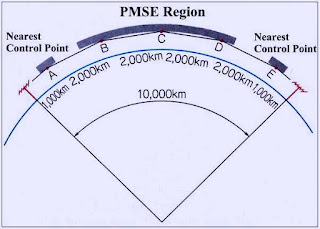 |
| courtesy: JE1BMJ |
Signals travel through the polar region and never touch the ground until the far end of the path is reached. In all probability, this is the same mechanism that west coast stations are able to work transpolar-Es into Europe during the summer. The season is short-lived (June/July) and openings can have weak rapidly fading signals or, as in yesterday's case, strong steady signals during the course of the opening. Openings can last from just a few minutes to several hours. Thanks to the Internet and real-time chat, most of these openings are no longer being missed.
Stations being worked via SSSP seem to be, for the most part, running high-power and / or large antenna systems. It is rare to work many of the 100 watt stations, although under good conditions, it does happen.
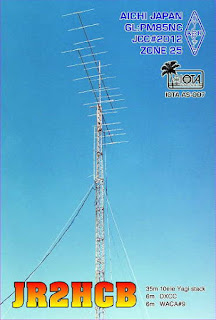 |
| JR2HCB's 6m Yagi Stack |
 Vatican Magic
Vatican Magic
| courtesy: K7CW |
June 21st was one of the better days of this year's poor Sporadic-E season. Stations in the western part of North America had an early-morning opening to the Caribbean as well as to South America, when YV1KK was worked by stations in the PNW region.
Here's how it happened here. I hadn't been paying attention to it, but N5DG had worked HVØA. Somebody mentioned that HVØA was going to QSY to 50.078 and was going to be looking for NA. I thought this choice of frequency was odd because some Europeans are not authorized to use frequencies below 50.080. But, I decided to go down there and check it out, because doing that has often paid off (re the CYØX QSO which brought me to start doing this). The propagation to the Caribbean and northern South America was demonstrably quite good (I worked my first YV), so checking out this European spot made even more sense.
I swung my beam up to a heading that I thought was good enough for Italy and tuned down on .078. Fortunately, there were no beacons coming through on that frequency, so I could concentrate on digging out any weak signal that was there. I slowly tuned around .078 and, for a while, heard nothing. After a few minutes, I began to sense that there was some tonal quality to the noise (musical noise). It was just there as no more than a hint, but I slowly tuned it so that it matched the frequency of my CW sidetone. I hoped that the other station (if there was one) would also have his filters set the same way. When I thought I had it about right, I switched in all my CW filters to the tightest setting (50 Hz) on both my transceiver and also my JPS NIR-12 outboard DSP filter. When I did this, the signal to noise ratio improved so well that I immediately started copying, "CQ NA CQ NA de HVØA HVØA" He was solid copy, but I needed those tight filters. I got his attention on the first call! He called me back using K8CW and gave me 599. I'm sure he was receiving me well, but probably didn't believe I was a 7. He kept calling me K8CW and I kept correcting him. I gave him a 599, too, but it was just a jerk-knee response that someone might do upon being the object of a miracle. But he was solid copy. After our QSO, I stopped hearing him. I logged him at 1631Z. The spotting record shows that N5DG and K7CW were the only North American stations to work HVØA on June 21 on 50 MHz. So, that's my side of the story.
| courtesy: K7CW |
No magic for me that day but kudos to Paul and his fine station, as well as to Francesco, for the heads-up operating and being on top of the short propagation window that morning!
 |
| courtesy: K7CW and https://www.qrz.com/ |
These are the moments that 6m diehards live for, especially those on the west coast ... reminding us once again why the 'magicband' deserves its well earned moniker.
 Summer Es
Summer Es
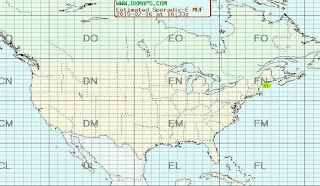 |
| courtesy: http://www.dxmaps.com/ |
There is no doubt about it.
This summer's Sporadic-E season has been the worst in memory, for myself and for most North American six-meter fans. My last log entry, and the last time that I heard a signal on 6m, was on July 7th. During a 'normal' season, rarely a day goes by without an opening in some direction. Often, the band will be open for several days in a row. It was only a few summers ago that the PNW region had propagation to Europe (extremely rare) for three days in succession!
There has been much speculation as to why this season is particularly poor. Is it the early higher-than-normal temperatures being experienced this summer? Is it the constant bombardment from the sun, with several solar flares during the prime weeks as well as an almost continuous coronal hole streaming? Is it all just a normal part of the cyclical behavior of most natural phenomena? Whatever the reason, time is running out for this year.
After operating on 6m for over 40 years, the peak conditions always seem to happen during or close to the first week of July ... but, living up to its 'sporadic' classification, I have seen some spectacular openings right up until early August. In fact, my longest 2m Es contact (Oklahoma) was made on July 24, so there is still some time left for the band to exonerate itself.
 |
| courtesy: http://www.swpc.noaa.gov/ |
One great opening over the pole will make the poor conditions just a distant memory!
 A More Optimistic Cycle 25
A More Optimistic Cycle 25
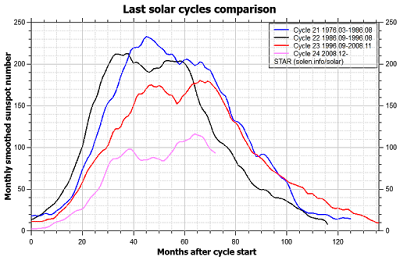 |
| courtesy: http://www.solen.info/solar/ |
With all of the doom and gloom forecasts for the upcoming solar cycles, I was reminded of the various prognostications that were made for our present Cycle 24. I recall one in particular, made in the winter of 2006 ...
Solar cycle 24, due to peak in 2010 or 2011 "looks like its going to be one of the most intense cycles since record-keeping began almost 400 years ago," says solar physicist David Hathaway of the Marshall Space Flight Center. He and colleague Robert Wilson presented this conclusion last week at the American Geophysical Union meeting in San Francisco.
So much for that prediction!
It seems that at least one group, led by Leif Svalgaard, got it right, as W4ZV recently reminded us on the Topband reflector ...
I had to do a memory refresh but finally recalled that Leif Svalgaard, et.al.
accurately predicted Cycle 24 in October 2004. He did not use conveyor
belt theory but polar field measurements:
"Using direct polar field measurements, now available for four solar
cycles, we predict that the approaching solar cycle 24 ( 2011 maximum) will
have a peak smoothed monthly sunspot number of 75 ± 8, making it
potentially the smallest cycle in the last 100 years."
http://www.leif.org/research/Cycle%2024%20Smallest%20100%20years.pdf
The actual smoothed sunspot peak for Cycle 24 was around 82 in early 2014
(blue line on the graph below). He missed the peak date because it
occurred during the cycle's second peak.
http://www.swpc.noaa.gov/products/solar-cycle-progression
73, Bill W4ZV
But Svalgaard wasn't the only one with an accurate forecast. Searching for a less-gloomy outlook for upcoming Cycle 25, I happened upon a paper by Hamid Helal and A.A. Galal of the National Research Institute of Astronomy and Geophysics, in Cairo. In "An early prediction of the maximum amplitude of the solar cycle 25", the authors cite a methodology that was bang-on for the last three cycles and gives a very optimistic outlook for Cycle 25.
Table 2 gives our prediction for cycle 25 in comparison with the published predictions of other authors in chronologic alphabetic order. It is obvious that our results agree with some contributions and disagree with others. In fact the differences of the predicted strengths by different authors may be attributed to the variety of the used techniques and methodology. Although some authors think that cycle 25 could be one of the weakest in centuries, in contrast, we think that the next cycle will be relatively stronger than cycle 24 and it will have nearly the same strength of cycle 23, i.e. the sunspot maximum may rebound in the near future.
 |
| courtesy: http://www.sciencedirect.com |
If Cycle 25 is comparable to Cycle 23 it will be happy days again ... it was a very robust cycle and provided several winters of high F2 MUFs, leading to day after day of amazing 50MHz propagation!
I'm somewhat vexed about which scenario I'd prefer, being both an LF'er (quiet, weak cycle) and a diehard 6m guy (chaotic, strong cycle). In any event, Cycle 25 will likely be the last one of any interest to me. I was born at the peak of Cycle 18 ... you do the math!
Obviously it will be a few years yet before we see who is right, but I'm kind of pulling for Helal and Galal's big numbers for one last 6m hoorah!
 Summer Solstice Magic
Summer Solstice Magic
As I write this on Sunday evening, June 21st, the magic band has been open here for over 16 hours straight and shows no signs of slowing down! What has been one of the poorest Sporadic-e seasons in memory, did not disappoint today, on what should theoretically be the peak day of the season.
A loud NØLL in Kansas was the first station heard this morning at around 0600 local time but I suspect the band had been open even earlier, judging by the strength of the signals. It didn't take long for the band to stretch out further and not too much later, signals from the Caribbean were making it into southern British Columbia, as well as many parts of North America.
At times the band seemed as crowded as 20m CW during the Sweepstakes as so many of the CW stations congregate in the 20KHz slot just below 50.100MHz. Before breakfast, the following stations were in the log:
ZF1EJ Cayman Islands
9Y4D Trinidad
YV1KK Venezuela
6Y5WJ Jamaica
KP4EIT Puerto Rico
XE2MVY Mexico
XE2X Mexico
WP3C Puerto Rico
NP4BM Puerto Rico
Around 10 am local time, the VA5MG beacon was suddenly heard pounding away ... often a good sign that propagation may be going 'polar'. Sure enough, stations to my south (Oregon and Washington) started to hear and work Europe. I was lucky enough to hear what can only be described as the contact of a lifetime, when K7CW (about 140 miles to the south) was heard working HVØA, the Vatican!! Paul was apparently in the sweet spot of the moment and his efficient homebrew array was up to the job. Over the next hour or so, the European propagation swung wildly between W7 and W6 as well as points to the east. The only Europeans that I heard were two Italian stations, briefly hitting 559 but unable to hear me. Johnny, KE7V (and also the brother of K7CW), about 40 miles to my south, managed to work both stations ... it seems that we were both just on the northern edge of the teasing footprint.
At times, several in band 'growly' carriers with polar flutter were heard as well as weak signals from some of the 49MHz videos still operating in central Europe.
It will be interesting to see if we have a repeat of this prop tomorrow (Monday) but I rather suspect much of this was the result of two well-placed solar flares earlier in the morning and will not be repeated ... I hope I'm wrong!
Impact from the flares plus a slower moving one is expected later today.
A loud NØLL in Kansas was the first station heard this morning at around 0600 local time but I suspect the band had been open even earlier, judging by the strength of the signals. It didn't take long for the band to stretch out further and not too much later, signals from the Caribbean were making it into southern British Columbia, as well as many parts of North America.
At times the band seemed as crowded as 20m CW during the Sweepstakes as so many of the CW stations congregate in the 20KHz slot just below 50.100MHz. Before breakfast, the following stations were in the log:
ZF1EJ Cayman Islands
9Y4D Trinidad
YV1KK Venezuela
6Y5WJ Jamaica
KP4EIT Puerto Rico
XE2MVY Mexico
XE2X Mexico
WP3C Puerto Rico
NP4BM Puerto Rico
 |
| courtesy: https://www.google.ca/maps |
At times, several in band 'growly' carriers with polar flutter were heard as well as weak signals from some of the 49MHz videos still operating in central Europe.
It will be interesting to see if we have a repeat of this prop tomorrow (Monday) but I rather suspect much of this was the result of two well-placed solar flares earlier in the morning and will not be repeated ... I hope I'm wrong!
 Fluorescent Light QRN
Fluorescent Light QRN
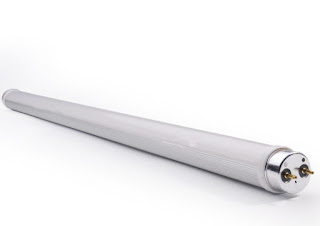
A recent posting on the ON4KST 6m Chat page brought up the question of QRN coming from fluorescent lighting.
Lefty, K1TOL, had a lot of QRN coming from his neighbour's garage, about 1,000 feet away. He solved the problem by changing the ballasts, purchased at Home Depot. This is the ballast that solved his problem, so if you are having similar difficulty, perhaps this will be of benefit.
Sometimes just changing to a different bulb type (manufacturer) will solve the problem as well but from what I have read, you get what you pay for and likely the bargain-bin bulbs are not the quietest.












